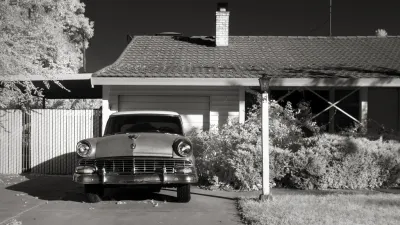A recent set of articles in the Economist argued that the continued spread of suburbia was inevitable and perhaps desirable. But the article's arguments are not always applicable to North America.

The Economist magazine recently ran a series of articles trying to defend suburbia, along the same lines that were common in the 1990s; rather than trying to deny the harmful social and environmental impacts of suburban sprawl, the articles argued that sprawl is popular and inevitable. Much of the article is about developing nations such as China and India; I lack the expertise to discuss suburbanization in these places. However, it seems to me that many of the articles' statements are irrelevant to the United States and Canada. To name a few:
1. “[A]lmost every city is becoming less dense.” This is the old “everyone does it” theory of suburban sprawl: its just a worldwide trend, nothing we can do about it. Of course, this sort of argument completely overlooks distinctions of degree. Does anyone really think there’s no difference between Vancouver and Phoenix, or between Amsterdam and Detroit?
2. “The simple truth is that people become richer they consume more space.” So, logically, as American wages have stagnated over the past several decades, suburbia should have stopped in its tracks long ago. (Somehow this failed to occur, at least until the last decade or so). Moreover, if this were true, our nation’s declining industrial regions, like Buffalo and Detroit, would have become hubs of urbanization, while rich regions, like San Francisco and New York, would have turned into huge versions of Phoenix. In fact, the richest regions have growing central cities—and were it not for restrictive zoning, these central cities would probably be growing more far more rapidly. By contrast, cities in stagnant regions, such as Detroit and Buffalo, generally continue to lose population decade after decade (though even these regions are starting to experience downtown growth).
To be fair, there may be some truth in this argument in the developing-world context: perhaps people use more wealth to buy more space up to some minimal level of affluence. But the sprawl/wealth correlation does not seem so strong in the United States.
3. “American city centres sometimes seem to revive, as Chicago did in the 1990s, only to fall back again; meanwhile, their suburbs continue to expand.” First of all, out of 131 incorporated places with over 175,000 people, only 14 fit this generalization (expanding in the 1990s, losing people in the 2000s). Most of these 14 were suburbs or small cities: only one other city with over 500,000 (Memphis) was one of them.
Even as applied to Chicago, this argument depends on the meaning of “city” and “suburb”: does “city” mean areas really near a region’s urban core (i.e. downtown), or does it mean anyplace that happens to be within the same municipality as that core? If you use the former definition, not only is Chicago reviving, but even cities like Cleveland that are continuing to lose people citywide. The parts of cities that are “falling back again” are usually more suburb-like areas further from downtown.
4. “suburbia, at its heart, is the embodiment of compromise.” I think the article was trying to say here that suburbanites balance commuting distance and affordability. But wait a minute—if people live in the suburbs because they can’t afford the city, then how is it the case that suburbia is a result of wealth (see claim 2 above)?
5. “An often-overlooked aspect of suburbia is variety.” Maybe in London (and in a few American regions with lots of commuter-train suburbs) this claim passes the straight-face test. But in most of the United States, sameness has become one of suburbia’s weaknesses: in too many metropolitan areas, almost every suburb shares the same huge, unwalkable streets, the same strip malls and big boxes behind yards of parking, the same cul-de-sac subdivisions. In most metropolitan areas, if you want to avoid automobile-oriented sprawl you have to live in your region's central city.
As the article points out, suburbia is changing, and new urbanist and pseudo-new urbanist developments are becoming more common in suburbia. But these developments are still quite rare.
Over the past few years, I've read my share of articles and blog posts alleging the inevitable downfall of suburbia—and given the limits (both political and physical) on urban infill, I think these claims are a bit overstated. On the other hand, The Economist articles may have bent a bit too far in the opposite direction.

Analysis: Cybertruck Fatality Rate Far Exceeds That of Ford Pinto
The Tesla Cybertruck was recalled seven times last year.

National Parks Layoffs Will Cause Communities to Lose Billions
Thousands of essential park workers were laid off this week, just before the busy spring break season.

Retro-silient?: America’s First “Eco-burb,” The Woodlands Turns 50
A master-planned community north of Houston offers lessons on green infrastructure and resilient design, but falls short of its founder’s lofty affordability and walkability goals.

Test News Post 1
This is a summary

Analysis: Cybertruck Fatality Rate Far Exceeds That of Ford Pinto
The Tesla Cybertruck was recalled seven times last year.

Test News Headline 46
Test for the image on the front page.
Urban Design for Planners 1: Software Tools
This six-course series explores essential urban design concepts using open source software and equips planners with the tools they need to participate fully in the urban design process.
Planning for Universal Design
Learn the tools for implementing Universal Design in planning regulations.
EMC Planning Group, Inc.
Planetizen
Planetizen
Mpact (formerly Rail~Volution)
Great Falls Development Authority, Inc.
HUDs Office of Policy Development and Research
NYU Wagner Graduate School of Public Service


























